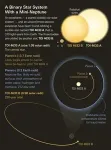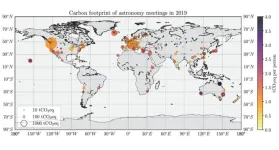(Press-News.org) A team of astronomers and citizen scientists has discovered a planet in the habitable zone of an unusual star system, including two stars and potentially another exoplanet.
The planet hunters spotted the Neptune-like planet as it crossed in front of its host star, temporarily dimming the star’s light in a way akin to a solar eclipse on Earth. This ‘transit method’ usually identifies planets with tight orbits, as they are more likely to follow paths that put them between Earth and their host star and, when following such paths, move into light-blocking positions more frequently. That’s why this newly discovered planet is considered unusually far out, with the planet taking 272 days to lap its star. Furthermore, the star is now by far the brightest one known to host a transiting planet in the habitable zone where liquid water can exist.
Follow-up observations of the system revealed even more peculiarities. The star is also orbited by a still unconfirmed second planet with a 34-day orbit and, perhaps most interestingly, another star. The unique system provides a valuable data point for scientists trying to understand how planets form and remain in stable orbits in multi-star systems. The researchers present their discoveries April 30 in The Astrophysical Journal.
“Finding planets in multi-star systems is crucial for our understanding of how you can make different planets out of the same material,” says study lead author Nora Eisner, a research fellow at the Flatiron Institute’s Center for Computational Astrophysics in New York City.
Systems of stars and planets form when clouds of gas and dust begin clumping together. When a star forms alongside another star, the pair can form a binary star system. Because planets are estimated to be half as likely to form in a binary star system compared to single-star systems, Eisner says “it’s quite exciting that we found this one.”
The newfound planet — formally called TOI 4633 c, but nicknamed Percival (after a character from the “Harry Potter” book series) by the scientists — was first identified by citizen scientists sifting through data collected by NASA’s Transiting Exoplanet Survey Satellite (TESS). The Planet Hunters TESS program enables anyone with a computer connected to the internet to search for undiscovered planets in the TESS data.
“Every time I spot a possible transit, I can feel my heart beat faster and my excitement rise extensively,” says Simon Bentzen, a Danish citizen scientist who has volunteered with Planet Hunters TESS since 2018. “I’m very happy that I helped find the new system. I hope that the new planets can help contribute to our understanding of planet formation and help answer other interesting planetary questions.”
The citizen scientists help the astronomers sort through the enormous datasets, which are far too large for researchers to analyze on their own. To date, the project has allowed over 43,000 volunteers from 90 countries to help catalog some 25 million objects. Citizen scientists are particularly invaluable in finding long-orbit exoplanets because these objects are hard for computers to identify.
“The human brain has a really incredible ability to recognize patterns and to filter out noise,” says Eisner, who is the principal investigator of Planet Hunters TESS. “While our algorithms struggle to identify these longer-period planets, the citizen scientists don’t.”
After 15 citizen scientists flagged the possible planet, Eisner and her team decided to take a closer look. Follow-up study of the star’s radial velocity — which looked for tiny wobbles in the star’s movement that reveal the gravitational tug of nearby companions — showed a potential second planet close to the star.
Further images and archival data revealed that what the scientists first thought was a single star is in fact two. The two co-orbiting stars are currently too close together to be distinguished individually from our vantage point on Earth. However, archival observations of the star collected over the past 119 years showed that the system is indeed a pair of binary stars.
The new exoplanet has the second-longest orbit of any planet discovered with TESS data and is one of only five with orbits longer than 100 days. “This planet is remarkable in many aspects,” Eisner says. “It’s remarkable in its orbit, it’s remarkable for being in the habitable zone and it’s remarkable for orbiting a bright star.”
While the scientists do think the planet is in the habitable zone, they would not advise it as a destination for your next interstellar vacation. TOI 4633 c has no solid surface, and the atmosphere is probably thick with water vapor, hydrogen and methane. However, previous studies have shown that long-period planets are more likely to have satellites or moons, which may offer solid surfaces for life to take hold.
“If this planet were to have a moon, that moon would likely have a solid surface, which could then be a great place to find water,” Eisner says. In the future, the exoplanet could be targeted by exomoon detection campaigns given the system’s brightness and the planet’s long orbit, both of which are helpful for exomoon detection.
While scientists are keen to learn more about this system, it will be at least 30 years before the two stars are far enough apart for them to determine the exact layout of the stellar system. Confirming whether the planets orbit the same star or different ones could help improve our understanding of how long such systems can remain stable. It could also help scientists make better predictions for finding new exoplanets. Indeed, nearly half of all sunlike stars occupy multi-star systems.
“If we were able to constrain where the planets orbit, it would really offer a stepping stone to open up our understanding of exoplanet formation,” Eisner says. “It could also possibly help us someday be able to look at a star and its properties and make some guesses about what planets are potentially orbiting in that system.”
Eisner encourages people interested in volunteering with Planet Hunters TESS to check out the project’s website.
ABOUT THE FLATIRON INSTITUTE
The Flatiron Institute is the research division of the Simons Foundation. The institute's mission is to advance scientific research through computational methods, including data analysis, theory, modeling and simulation. The institute's Center for Computational Astrophysics creates new computational frameworks that allow scientists to analyze big astronomical datasets and to understand complex, multi-scale physics in a cosmological context.
END
Citizen scientists help discover record-breaking exoplanet in binary star system
With an unusually long orbit, the new planet spotted by volunteer planet hunters and confirmed by Flatiron Institute scientists and their colleagues offers insights into how planets form and remain stable in multi-star star systems
2024-04-30
ELSE PRESS RELEASES FROM THIS DATE:
Tambourine Philanthropies commits over $5 million in new funding for research into ALS, in partnership with the Milken Institute
2024-04-30
WASHINGTON, DC (April 30, 2024)—Tambourine Philanthropies (Tambourine), in partnership with the Milken Institute Science Philanthropy Accelerator for Research and Collaboration (SPARC), is pleased to announce the recipients of its ALS Breakthrough Research Fund. Tambourine has committed over $5 million total to eight teams around the world for basic and discovery-focused research aiming to change how we understand and treat amyotrophic lateral sclerosis (ALS).
Tambourine launched the ALS Breakthrough Research ...
E-bike incentives prove to be worth the investment
2024-04-30
Electric bicycle rebates have exploded in popularity in North America as transportation planners try to get people out of their cars and into healthier, more climate-friendly alternatives. However, there is limited understanding of the full impacts of these incentives.
Are new cycling habits sustainable? Who benefits most from these incentives? And are they worth the cost?
Researchers at UBC’s Research on Active Transportation (REACT) Lab have some answers. They surveyed participants in an e-bike incentive program offered by the District of ...
Trotting robots reveal emergence of animal gait transitions
2024-04-30
With the help of a form of machine learning called deep reinforcement learning (DRL), the EPFL robot notably learned to transition from trotting to pronking – a leaping, arch-backed gait used by animals like springbok and gazelles – to navigate a challenging terrain with gaps ranging from 14-30cm. The study, led by the BioRobotics Laboratory in EPFL’s School of Engineering, offers new insights into why and how such gait transitions occur in animals.
“Previous research has introduced energy efficiency and musculoskeletal injury avoidance as the two main explanations ...
Lundquist investigator Dr. Ashraf Ibrahim is the lead author in the landmark study on pioneering oral fungal infection treatment showing promise in preclinical trials
2024-04-30
A novel oral amphotericin B (MAT2203) developed by Matinas BioPharma for treatment of invasive mucormycosis (IM) and other deadly invasive fungal infections, has demonstrated encouraging results in a series of preclinical studies. The groundbreaking research, led by Lundquist Institute (TLI) Investigator Ashraf Ibrahim, PhD, has been published in the journal Antimicrobial Agents and Chemotherapy.
The studies focused on MAT2203, an oral lipid nanocrystal formulation of amphotericin B, which has previously demonstrated safety and effectiveness in the clinical treatment of various fungal infections. The research aimed ...
Deep-learning decoding for a noninvasive brain-computer interface
2024-04-30
Brain-computer interfaces (BCIs) have the potential to make life easier for people with motor or speech disorders, allowing them to manipulate prosthetic limbs and employ computers, among other uses. In addition, healthy and impaired people alike could enjoy BCI-based gaming. Non-invasive BCIs that work by analyzing brain waves recorded through electroencephalography are currently limited by inconsistent performance. Bin He and colleagues used deep-learning decoders to improve a BCI’s performance responding to ...
Elucidating the role of a shared lncRNA-miRNA-mRNA network in exacerbating Parkinson’s disease symptoms in the context of COVID-19 infection
2024-04-30
Background and objectives
Parkinson’s disease (PD) is a common neurodegenerative disorder with unclear molecular mechanisms. Noncoding RNAs, such as microRNAs (miRNAs) and long noncoding RNAs (lncRNAs), have been identified as critical regulators of gene expression. This study aimed to investigate the triple network of lncRNA-miRNA-mRNA, known as competing endogenous RNAs (ceRNAs), and to identify essential lncRNAs that regulate PD-related gene expression through their target miRNAs. The study also identified a common triple network between COVID-19 and PD that may contribute to exacerbating PD symptoms.
Methods
A bioinformatics approach was employed to construct ...
American College of Lifestyle Medicine announces unique screening tool for clinicians to efficiently assess patient dietary patterns
2024-04-30
The American College of Lifestyle Medicine (ACLM) has developed a clinical tool to help health care professionals incorporate a food as medicine approach into their practice by assessing and tracking the proportion of whole, unrefined plant-based foods and water intake in their patients’ dietary patterns.
The ACLM Diet Screener, a 27-item diet assessment tool available free on ACLM’s website, was designed to guide clinical conversations around diet and support nutrition prescriptions, while also being brief enough for use during routine ...
Cranberry extracts could boost microbiota and counter cardiometabolic diseases
2024-04-30
Québec, April 30, 2024 - Cranberry extracts appear to improve intestinal microbiota and help prevent chronic diseases such as diabetes and cardiovascular diseases. The study of Université Laval and the Institute of Nutrition and Functional Foods (INAF) reported beneficial effects after only four days of use.
Cranberries and berries are associated with multiple health benefits, mainly attributed to their high content of polyphenols, in the form of tannins. They also contain high concentrations of oligosaccharides, small fibres that are thought to contribute to their bioactivity.
The research team, led by Yves Desjardins, professor ...
Discovery of uranium-contaminated soil purification material without secondary environmental pollution
2024-04-30
Nuclear energy has long been regarded as a next-generation energy source, and major countries around the world are competing to secure cutting-edge technologies by leveraging the high economic efficiency and sustainability of nuclear power. However, uranium, which is essential for nuclear power generation, has serious implications for both soil ecosystems and human health. Despite being a key radioactive material, uranium poses significant health risks due to its chemical toxicity to the kidneys, bones, and cells. As a result, both the U.S. Environmental Protection Agency and the World Health Organization recommend allowing and advocating for uranium concentrations in wastewater ...
The carbon emissions of academic astronomy
2024-04-30
The carbon emissions associated with air travel to professional conferences make up a sizable fraction of the emissions produced by academia. Andrea Gokus and colleagues estimated the CO2-equivalent emissions for conference travel to all 362 open meetings in the field of astronomy in 2019. The total is an estimated 42,500 tCO2e, or about one ton per participant per meeting. According to the authors, networking and discussing new scientific developments at meetings is important for advancing the field, but adjustments can be made to reduce the hefty carbon cost. Holding meetings virtually ...
LAST 30 PRESS RELEASES:
Researchers identify gene that calms the mind and improves attention in mice
Artificial metabolism turns waste CO2 into useful chemicals
Ancient sea anemone sheds light on animal cell type evolution
Begging gene leads to drone food
How climate policies that incentivize and penalize can drive the clean energy transition
Can community awareness campaigns in low-resource areas improve early diagnosis of colorectal cancer?
Stardust study resets how life’s atoms spread through space
Practical education: Clinical scenario-based program development
The impact of family dynamics on eating behaviour – how going home for Christmas can change how you eat
Tracing the quick synthesis of an industrially important catalyst
New software sheds light on cancer’s hidden genetic networks
UT Health San Antonio awarded $3 million in CPRIT grants to bolster cancer research and prevention efforts in South Texas
Third symposium spotlights global challenge of new contaminants in China’s fight against pollution
From straw to soil harmony: International team reveals how biochar supercharges carbon-smart farming
Myeloma: How AI is redrawing the map of cancer care
Manhattan E. Charurat, Ph.D., MHS invested as the Homer and Martha Gudelsky Distinguished Professor in Medicine at the University of Maryland School of Medicine
Insilico Medicine’s Pharma.AI Q4 Winter Launch Recap: Revolutionizing drug discovery with cutting-edge AI innovations, accelerating the path to pharmaceutical superintelligence
Nanoplastics have diet-dependent impacts on digestive system health
Brain neuron death occurs throughout life and increases with age, a natural human protein drug may halt neuron death in Alzheimer’s disease
SPIE and CLP announce the recipients of the 2025 Advanced Photonics Young Innovator Award
Lessons from the Caldor Fire’s Christmas Valley ‘Miracle’
Ant societies rose by trading individual protection for collective power
Research reveals how ancient viral DNA shapes early embryonic development
A molecular gatekeeper that controls protein synthesis
New ‘cloaking device’ concept to shield sensitive tech from magnetic fields
Researchers show impact of mountain building and climate change on alpine biodiversity
Study models the transition from Neanderthals to modern humans in Europe
University of Phoenix College of Doctoral Studies releases white paper on AI-driven skilling to reduce burnout and restore worker autonomy
AIs fail at the game of visual “telephone”
The levers for a sustainable food system
[Press-News.org] Citizen scientists help discover record-breaking exoplanet in binary star systemWith an unusually long orbit, the new planet spotted by volunteer planet hunters and confirmed by Flatiron Institute scientists and their colleagues offers insights into how planets form and remain stable in multi-star star systems









